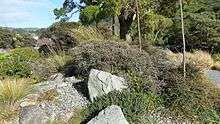Leonard Cockayne

Leonard Cockayne FRS[1] (7 April 1855 – 8 July 1934) is regarded as New Zealand's greatest botanist and a founder of modern science in New Zealand.[2]
Biography
He was born in Sheffield, England where he attended Wesley College. He travelled to Australia in 1877 and shortly moved on to New Zealand where he became established as a botanist.
In June 1901, he attended the first conference of horticulturists in New Zealand at Dunedin where he presented a paper on the plants of the Chatham Islands and advocated the establishment of experimental plant research stations in New Zealand. This helped to establish Cockayne's reputation.
Cockayne was a member of the 1907 Sub-Antarctic Islands Scientific Expedition. The main aim of the expedition was to extend the magnetic survey of New Zealand by investigating Auckland and Campbell Islands but botanical, biological and zoological surveys were also conducted. The voyage also resulted in rescue of the castaways of the shipwreck the Dundonald in the Auckland Islands.
Cockayne's major contributions to botany were in plant ecology and in his theories of hybridisation. In 1899 he published the first New Zealand account of successional changes in vegetation. Between 1897 and 1930 he published 49 papers in the Transactions and Proceedings of the Royal Society of New Zealand.[3]
He was elected Fellow of the Royal Society in 1912 on the proposal of Sir J. D. Hooker and was awarded the Hector Memorial Medal in that same year. In 1914 he was awarded the Hutton Memorial Medal.
Cockayne corresponded frequently with famous botanists all over the world. This helped facilitate the publication of New Zealand papers in overseas journals. He was also instrumental in bringing visitors to New Zealand. Johannes Paulus Lotsy, the Dutch botanist, lectured on the place of hybrids in evolution. The Swedish couple Einar and Greta Du Rietz stayed six months in the summer of 1926–27 collecting from the Far North to the subantarctic islands, paying special attention to lichens. The director of Kew Gardens, Sir Arthur Hill, came in 1928.[4]
Cockayne also assisted and encouraged fellow botanists in their work. He was thanked by coauthors Robert Malcolm Laing and Ellen Wright Blackwell in the preface of their classic book of New Zealand biology Plants of New Zealand for "helping us over many slippery places and for much generous assistance freely given”.[5] He encouraged Charles Ethelbert Foweraker, later senior lecturer in botany, and sometime lecturer in charge of the Forestry School, at the University of Canterbury, in his career, the two men having first corresponded in 1911 when Cokayne was writing 'The Vegetation of New Zealand'; the two went together on many expeditions in Marlborough and Canterbury.[6]

The Cockayne Reserve in Christchurch, the Cockayne Nature Walk[7] near Otira on the West Coast, and the Cockayne Lookout in Otari-Wilton's Bush (Wellington) dedicated solely to New Zealand native plants, are all named after him. His son Alfred Cockayne also became a noted botanist.[8]
Bibliography
- New Zealand Plants and Their Story 1910
- Observations Concerning Evolution, Derived from Ecological Studies in New Zealand
- Vegetation of New Zealand
- The Cultivation of New Zealand Plants 1923
- Trees of New Zealand (with E. Phillips Turner)
- Report on the dune-areas of New Zealand: their geology, botany and reclamation.
- Report on a botanical survey of Stewart Island
- Cockayne, Leonard (1921). Die Vegetation der Erde. Sammlung pflanzengeographischer monographien (in German). XIV: The Vegetation of New Zealand. Leipzig: W. Engelmann. Retrieved 4 April 2009.
References
- ↑ Hill, A. W. (1935). "Leonard Cockayne. 1855-1934". Obituary Notices of Fellows of the Royal Society. 1 (4): 442. doi:10.1098/rsbm.1935.0008.
- ↑ Thomson, A.D. "Cockayne, Leonard". Dictionary of New Zealand Biography. Ministry for Culture and Heritage. Retrieved 8 February 2016.
- ↑ "Transactions and Proceedings of the Royal Society of New Zealand 1868-1961". National Library of New Zealand. Retrieved 26 September 2011.
- ↑ Lucy Moore (2008). Priestley, Rebecca, ed. The Awa book of New Zealand science. Wellington, New Zealand: Awa Press. p. 151. ISBN 9780958262996.
- ↑ Godley, E. J. (June 2009). "Biographical Notes (73): Ellen Wright Blackwell (c. 1864–1952) & Frank Bartram Blackwell (c. 1862–1934)" (PDF). New Zealand Botanical Society Newsletter (96): 15–22. Retrieved 16 March 2015.
- ↑ http://www.science.canterbury.ac.nz/nzns/issues/vol10-1982/burrows_a.pdf
- ↑ ledzep (5 December 2010). "Cockayne Nature walk". Tracks. Retrieved 10 August 2012.
- ↑ Nightingale, Tony. "Alfred Hyde Cockayne". Dictionary of New Zealand Biography. Ministry for Culture and Heritage. Retrieved December 2011. Check date values in:
|access-date=(help) - ↑ IPNI. Cockayne.
External links
| Wikimedia Commons has media related to Leonard Cockayne. |
- the 1966 Encyclopaedia of New Zealand
- Leonard Cockayne: Horticulturist
- Biography in Botanical Discovery in New Zealand: The Resident Botanists by W. R. B. Oliver